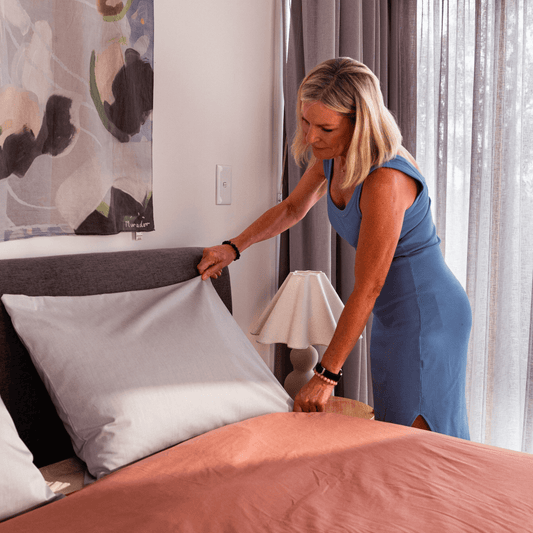
Why is My Grounding Product Shocking Me?
You expect your grounding device (grounding mat, sheet, rod, or wire) to be gentle and safe. But instead, you feel a sharp tingle or zap.
Why is it happening? In this article, I explain common causes, how to diagnose them, and what you can do to avoid being shocked again.
Quick Summary Table
| Problem Type | Likely Cause | What To Do |
|---|---|---|
| One-time zap | Static electricity | Humidify room, wear cotton |
| Tingling during use | Induced current or poor wiring | Move cords, test outlet |
| Repeated or strong shocks | Faulty resistor or grounding issue | Replace parts, contact electrician |
What Does “Shocking” Mean in This Context?
When people say “grounding device is shocking me,” they usually mean:
- A sharp shock or zap when first touching the device
- A tingling or prickle while in contact
- A weak but continuous sensation near electronics or walls
These do not always mean danger. But they do signal a problem you should fix.
Common Causes of Shocks from Grounding Devices
Static discharge
Dry air, synthetic fabrics, and walking on carpets all build up static. When you touch your grounding wire or mat, that static energy jumps. It feels like a zap.
This is often harmless.
Poor or missing earth/ground wiring
If your house wiring doesn’t have a proper earth connection, the grounding device may not really be grounded. That leaves the device floating and prone to picking up stray currents.
Electromagnetic induction from nearby power lines or wiring
If an electrical line or appliance runs close to your grounding wire or mat, it can induce a weak alternating current (AC). You might feel this as a tingle.
“Dirty electricity” or voltage on earth
Sometimes excess voltage or noise travels through the earth line (e.g. due to faulty appliances or wiring). If your device doesn’t have the proper resistor or safety features, that voltage can be felt.
Defective components or a missing resistor
Safety in grounding devices usually includes a built-in resistance (e.g., 100 kΩ). If this is missing or malfunctioning, you might feel more of the current than intended.
How to Diagnose the Cause (Simple Tests)
Use this checklist to pinpoint the reason:
- Check fabric and humidity: Is the room dry? Are you wearing synthetic clothes? Try barefoot and in cotton.
- Use an outlet tester: Plug in a socket tester to see if your outlet is wired correctly (live/neutral /earth).
- Continuity test: Measure resistance between your grounding wire and a known earth (e.g., plumbing or outdoor ground rod).
- Move away from appliances: Disconnect or switch off nearby high-power devices and test again.
- Try an external ground rod: Temporarily connect your device to an outdoor earth rod far from the house wiring and see if the sensation stops.
You might need a multimeter or ask someone with basic electrical skills to help.
Is It Dangerous?
Most mild shocks or tingles from grounding devices are not harmful, especially if your device includes safety resistance. But continuous or painful jolts could point to wiring issues that are dangerous. Always treat unexpected electricity sensations seriously.
How to Avoid Being Shocked Again
-
Use devices with built-in resistors
- Always choose grounding mats or sheets that include a safety resistor (e.g., 100 kΩ). This limits current flow.
-
Manage static
- Increase humidity indoors (use a humidifier)
- Wear natural fibres (cotton, linen)
- Avoid walking on synthetic rugs or carpets when grounding
-
Improve wiring and earthing
- Ensure your outlet earth/ground pin is properly connected
- Get a licensed electrician to test and correct wiring
- Avoid grounding through sockets with known wiring issues
-
Install a dedicated earth rod
- An external ground rod, placed away from electrical circuits, gives you a clean earth reference. Connect your grounding device there if the internal wiring is noisy.
-
Route your ground wiring carefully
- Keep the grounding wire away from high-voltage cables, power strips, transformers, and heavy appliances. Use twist lines or shielded cable where possible.
What to Do if You Still Feel Shocks
- Stop using the device until you find the cause
- Contact an electrician and show them your tests
- Replace suspect parts (earthing cables, connectors, resistors)
- Opt for a refund or a warranty if the device is faulty
- Start with simple fixes: humidity, fabric change, and wiring check
Final Thoughts
Grounding devices are meant to help, not shock. If you feel a zap or continual tingle, treat it as a signal that something’s off, either static, wiring, or a device fault.
Use the tests above, improve your environment, and when in doubt, get a professional to inspect.
Frequently Asked Questions
1. Is it normal to feel tingling when using a grounding mat?
A light tingle can happen from induced electrical fields or static discharge. It’s normal if it’s mild and short. If it’s strong or constant, check your outlet or move to another area.
2. Can grounding devices be dangerous?
Properly made grounding products with built-in resistors are safe. However, if your house wiring is faulty or you use a cheap device without protection, you could feel more than just a tingle.
3. Will using a ground rod instead of a wall socket help?
Yes, if your wall sockets aren’t properly grounded, using a separate outdoor rod can reduce interference and make grounding cleaner and safer.
4. How can I tell if my grounding sheet has a resistor?
Most quality grounding cables list the resistance (e.g., 100 kΩ) in the product specs. You can also test it using a grounding multimeter between both ends of the cord.
5. Should I unplug the device when not in use?
It’s a good safety habit to unplug grounding devices when you’re not using them, especially if storms or electrical work are happening nearby.










